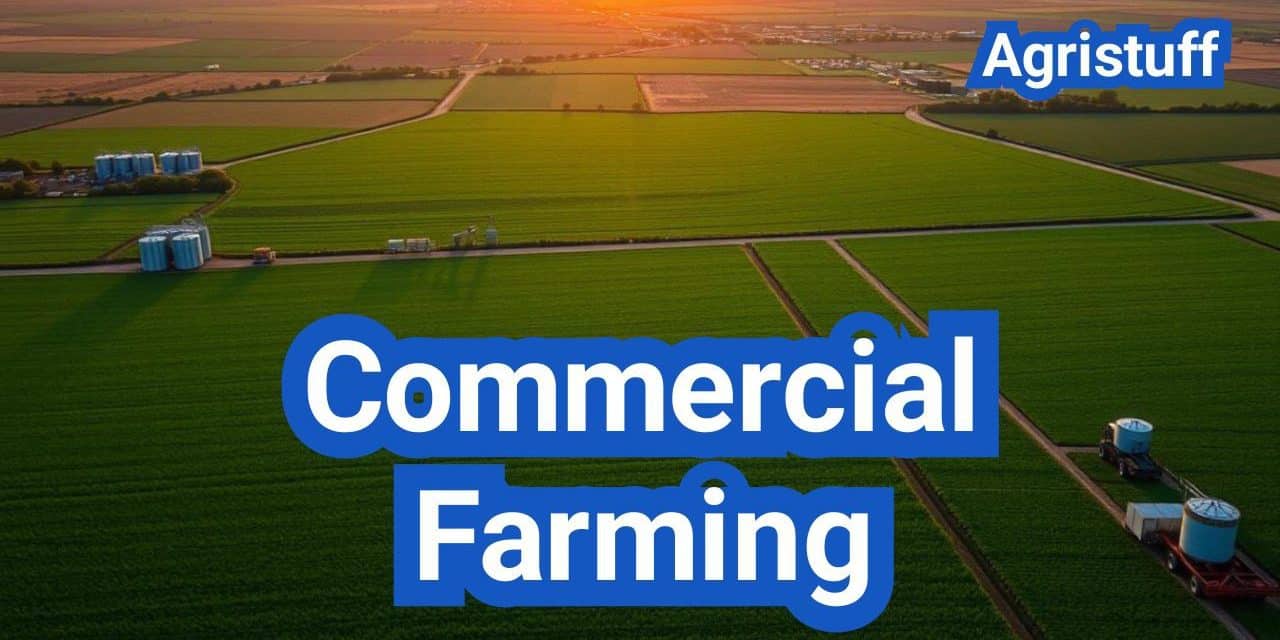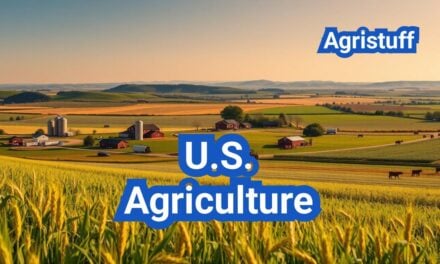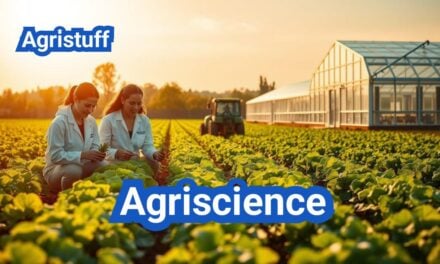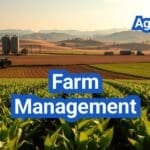Large-scale agricultural practices have become a cornerstone of the global food system, enabling the production of vast quantities of crops and livestock.
At its core, agribusiness involves raising crops and livestock for profit rather than personal consumption. This approach is characterized by the integration of technology and market-oriented strategies to maximize efficiency and output.
The significance of commercial agriculture cannot be overstated, as it provides a substantial portion of the world’s food supply. By leveraging advanced farming techniques and equipment, commercial farms can produce high-quality products while minimizing environmental impact.
Key Takeaways
- Commercial farming is a large-scale agricultural practice focused on producing crops and livestock for profit.
- Agribusiness involves the integration of technology and market-oriented approaches to maximize efficiency.
- The global food system relies heavily on commercial farming to meet the world’s food demands.
- Advanced farming techniques and equipment are used to minimize environmental impact.
- Commercial agriculture provides a substantial portion of the world’s food supply.
What Is Commercial Farming?
Commercial agriculture is defined by its emphasis on producing agricultural products for sale in the market. This approach to farming is fundamentally different from other forms of agriculture due to its focus on profit and large-scale production.
Commercial Agriculture Definition and Meaning
Commercial farming involves the cultivation of crops and the rearing of livestock on a significant scale, with the primary objective of generating income through the sale of these products. Intensive commercial agriculture and extensive commercial agriculture are two practices under this category, differing mainly in their methods and scale of production.
Intensive commercial farming focuses on maximizing output per unit area, often through the use of advanced technology and high-yielding crop varieties. In contrast, extensive commercial farming involves large areas of land and may not be as intensive in terms of input per hectare.
Differentiation from Subsistence Farming
The key distinction between commercial farming and subsistence farming lies in their objectives. While subsistence farming aims to produce food for the farmer’s family or local community, commercial farming is oriented towards producing for the market. This fundamental difference influences the scale, techniques, and economic impact of commercial farming.
| Characteristics | Commercial Farming | Subsistence Farming |
|---|---|---|
| Primary Objective | Profit through market sale | Family or local consumption |
| Scale of Production | Large scale | Small scale |
| Use of Technology | Advanced technology | Limited technology |
Historical Evolution of Commercial Agriculture
Commercial agriculture has undergone significant transformations over the centuries, driven by technological advancements, changes in market demand, and the need for increased efficiency. From the early days of mechanized farming to the current era of precision agriculture, commercial farming has evolved to become more productive and sustainable.
The historical evolution of commercial agriculture is marked by key milestones, including the introduction of new farming techniques, the development of irrigation systems, and the integration of technology in farm operations.
Key Characteristics of Commercial Farming

Commercial farming is characterized by its extensive production methods and business-oriented approach. This form of agriculture is designed to produce large quantities of crops or livestock for sale, with the primary goal of generating profit.
Large-Scale Production Methods
One of the defining features of commercial farming is its reliance on large-scale production methods. This involves cultivating vast areas of land or raising large numbers of livestock to maximize output. Commercial farms often employ advanced machinery and technology to streamline their operations and reduce labor costs.
- Use of heavy machinery for planting, harvesting, and processing
- Implementation of advanced irrigation systems for efficient water management
- Employment of precision agriculture techniques for optimized crop yields
Profit-Oriented Business Approach
Commercial farming operates as a profit-oriented business, with decisions driven by market demand and the potential for financial return. This approach influences choices regarding crop selection, farming practices, and investment in technology and equipment.
- Market research to identify profitable crops or livestock
- Investment in commercial farming equipment to increase efficiency
- Strategic planning to minimize costs and maximize profits
Market Integration and Distribution Networks
Effective market integration and robust distribution networks are crucial for the success of commercial farming operations. Farmers must connect with buyers, wholesalers, and retailers to ensure their products reach the market efficiently.
The use of technology plays a significant role in enhancing market integration and distribution. From online marketplaces to advanced logistics systems, technology helps farmers stay competitive in a global market.
Types of Commercial Farming Systems
Commercial farming is broadly classified into several systems, including intensive commercial farming, extensive commercial agriculture, mixed farming, and plantation agriculture. These systems are designed to cater to diverse agricultural needs and environments, playing a crucial role in meeting global food demands.
Intensive Commercial Farming
Intensive commercial farming involves the use of high-yielding crop varieties, advanced technology, and significant resources to maximize output per acre. This method is often used in regions with limited land availability, where the focus is on producing high volumes of crops or livestock.
Key features of intensive commercial farming include:
- High use of fertilizers and pesticides
- Advanced irrigation systems
- Mechanized farming equipment
- High-yielding crop and livestock breeds
Extensive Commercial Farming
Extensive commercial farming, on the other hand, involves farming over larger areas with less intensity. This method is often practiced in regions where land is abundant, and the focus is on producing crops or livestock with lower input costs.
Characteristics of extensive commercial farming include:
- Large land holdings
- Lower use of fertilizers and pesticides
- Less mechanization compared to intensive farming
- Focus on crops or livestock that are well-suited to the local climate and soil conditions
Mixed Farming Operations
Mixed farming involves the combination of different farming practices, such as growing multiple crops and raising livestock on the same farm. This approach helps in maintaining ecological balance, reducing dependence on a single crop, and improving farm resilience.
Benefits of mixed farming operations include:
- Diversified income streams
- Better soil health through crop rotation
- Reduced pest and disease pressure
- Improved biodiversity
Plantation Agriculture
Plantation agriculture is a type of commercial farming that focuses on the cultivation of a single crop, often on a large scale. Crops commonly grown in plantations include tea, coffee, rubber, and palm oil.
Key aspects of plantation agriculture include:
- Monoculture farming practices
- Large-scale production
- Specialized labor force
- Often involves significant investment in infrastructure and equipment
Commercial Farming Geography and Distribution

Commercial farming distribution is influenced by factors such as climate, soil quality, and market demand. The geography of commercial farming varies significantly across different regions, with certain areas being more conducive to specific agricultural practices.
Regional Distribution in the United States
The United States is a significant player in global commercial farming, with various regions specializing in different crops and livestock. The Great Plains are known for their extensive wheat and corn production, while California leads in the production of fruits and nuts.
Regional Specialization: Different regions in the U.S. have developed specialized agricultural practices based on their geographical and climatic conditions. For instance, the Midwest is often referred to as the “breadbasket” due to its rich soil and extensive grain production.
Agricultural Specialization by Region
Agricultural specialization by region is a key characteristic of commercial farming in the United States. Regions tend to focus on crops or livestock that are best suited to their local conditions, enhancing efficiency and productivity.
- The Midwest specializes in corn and soybeans.
- California is a leading producer of avocados, grapes, and almonds.
- The Great Plains are known for wheat production.
- Florida is a major producer of citrus fruits.
Economic Impact and Industry Statistics
Commercial farming has a significant economic impact, contributing to both national and local economies through job creation, income generation, and GDP contribution. According to the United States Department of Agriculture (USDA), the agricultural sector accounts for a substantial portion of the country’s economic output.
| Region | Primary Crops/Livestock | Economic Contribution |
|---|---|---|
| Midwest | Corn, Soybeans | $100 billion+ |
| California | Avocados, Grapes, Almonds | $50 billion+ |
| Great Plains | Wheat | $20 billion+ |
| Florida | Citrus Fruits | $10 billion+ |
The economic impact of commercial farming extends beyond direct agricultural production, influencing related industries such as food processing, transportation, and retail. As such, commercial farming plays a vital role in the overall health of the national economy.
Modern Commercial Farming Practices
Commercial farming today is characterized by the integration of cutting-edge technology and sustainable approaches. This fusion is transforming the agricultural landscape, enabling farmers to produce more while reducing their environmental footprint.
Technology Integration in Farm Operations
The use of advanced technology in commercial farming has revolutionized the way crops are grown and managed. Precision agriculture techniques, such as GPS-guided equipment and drone surveillance, allow for more accurate and efficient farming practices. These technologies help farmers optimize crop yields, reduce waste, and minimize environmental impact.
Moreover, farm management software and data analytics play a crucial role in decision-making. By analyzing data on weather patterns, soil health, and crop performance, farmers can make informed decisions to improve their operations.
Sustainable Commercial Farming Approaches
Sustainability is becoming increasingly important in commercial farming. Eco-friendly practices such as crop rotation, organic farming, and conservation tillage are being adopted to reduce the environmental impact of farming. These practices not only help preserve natural resources but also contribute to better soil health and biodiversity.
Additionally, many commercial farms are incorporating renewable energy sources, such as solar and wind power, to reduce their reliance on fossil fuels. This shift towards sustainability is not only beneficial for the environment but also enhances the long-term viability of the farm.
Precision Agriculture Techniques
Precision agriculture involves the use of advanced technology to optimize farming practices. Techniques such as precision irrigation, where water is delivered directly to the roots of plants, reduce waste and improve crop health. Similarly, precision planting ensures that seeds are planted at the optimal depth and spacing, maximizing yields.
The use of precision agriculture techniques is becoming more widespread in commercial farming, driven by the need to increase efficiency and reduce environmental impact. As technology continues to evolve, we can expect to see even more innovative solutions emerge in the field of commercial farming.
Commercial Vertical Farming Systems

Commercial vertical farming systems offer a cutting-edge solution for sustainable food production. These innovative agricultural practices are transforming the way we grow crops, making it possible to produce high yields in limited spaces.
Commercial Vertical Hydroponic Systems
One of the key components of commercial vertical farming is the use of hydroponic systems. Commercial vertical hydroponic systems allow for the cultivation of crops in a nutrient-rich solution rather than soil, promoting healthier plant growth and reducing water consumption.
These systems are highly efficient and can be integrated into vertical farming setups, maximizing space usage. By controlling the nutrient delivery system, farmers can optimize crop yields and reduce waste.
LED Lighting and Climate Control
LED lighting plays a crucial role in commercial vertical farming, providing the necessary spectrum and intensity for plant growth. LED lights are energy-efficient and can be tailored to specific crop requirements, enhancing photosynthesis and promoting healthy growth.
Climate control is another critical aspect of commercial vertical farming. By maintaining optimal temperature, humidity, and CO2 levels, farmers can create ideal growing conditions for a wide range of crops. This level of control helps in reducing crop losses due to adverse weather conditions.
Space Efficiency and Urban Applications
One of the significant advantages of commercial vertical farming systems is their ability to thrive in urban environments. By utilizing vertical space, these systems can be set up in urban areas, reducing transportation costs and increasing food freshness.
These systems also enable year-round production, regardless of the external climate or season. This consistency is crucial for meeting the demands of a growing urban population.
Commercial Hydroponic and Indoor Farming

Commercial hydroponic and indoor farming offer a controlled environment for crop production, enhancing sustainability and reducing environmental impact. These modern farming methods are gaining popularity due to their potential for high yields and efficient water use.
Hydroponic Farming Methods
Commercial hydroponic farming involves growing plants in a nutrient-rich solution rather than soil. This method allows for precise control over nutrient levels, pH, and water content, resulting in faster growth rates and higher yields.
The most common hydroponic systems used in commercial settings include:
- Nutrient Film Technique (NFT)
- Ebb and Flow (Flood and Drain)
- Drip Irrigation
These systems can be tailored to specific crop requirements, making them versatile for a wide range of produce.
Indoor Farming Setups
Commercial indoor farming setups involve growing crops in controlled environments, often within warehouses or repurposed buildings. These setups utilize advanced climate control systems, LED lighting, and sometimes hydroponic or aeroponic systems.
Key components of commercial indoor farming include:
- LED grow lights tailored to specific crop spectra
- Advanced climate control systems for temperature and humidity management
- Automated watering and nutrient delivery systems
According to a report by the Food and Agriculture Organization, “Indoor agriculture can increase crop yields while reducing water usage and environmental impact.”
“The future of farming is indoors, where we can control every aspect of the growing environment to maximize yield and minimize waste.” –
Dr. Dickson Despommier, Professor Emeritus, Columbia University
Benefits of Controlled Environment Agriculture
Controlled Environment Agriculture (CEA) offers numerous benefits, including improved crop yields, reduced water consumption, and the ability to grow crops year-round regardless of external weather conditions.
| Benefit | Description | Impact |
|---|---|---|
| Increased Yield | Optimal growing conditions | Higher productivity per square foot |
| Water Conservation | Recirculating hydroponic systems | Up to 90% less water usage |
| Year-Round Production | Climate-controlled environments | Consistent supply regardless of season |
As the global population continues to grow, commercial hydroponic and indoor farming will play a crucial role in meeting food demands sustainably.
Essential Commercial Farming Equipment

The backbone of commercial farming lies in its equipment, from tractors to irrigation systems. The right machinery is crucial for efficient and productive farming operations.
Tractors and Heavy Machinery
Tractors are the workhorses of commercial farming, used for a variety of tasks including plowing, tilling, and hauling. Heavy machinery like combines and harvesters are also essential for large-scale crop production.
Modern tractors are equipped with advanced technology such as GPS and auto-steering, which improve precision and reduce operator fatigue.
Irrigation Systems and Water Management Tools
Effective irrigation is critical for crop health and yield. Advanced irrigation systems can be controlled remotely and optimized based on soil moisture levels and weather forecasts.
Water management tools, including drip irrigation and sprinkler systems, help conserve water while ensuring crops receive adequate moisture.
Harvesting and Processing Equipment
Harvesting equipment, such as combines and forage harvesters, is designed to efficiently gather crops. Processing equipment like grain dryers and cleaners prepare the harvested crops for market.
The use of precision agriculture techniques in harvesting and processing can significantly reduce waste and improve crop quality.
Technology-Enhanced Farm Equipment
The integration of technology in farm equipment has revolutionized commercial farming. Autonomous tractors and drones are becoming increasingly common, improving efficiency and reducing labor costs.
Precision farming tools enable farmers to make data-driven decisions, optimizing crop yields and reducing environmental impact.
Commercial Fruit and Vegetable Farming

The commercial cultivation of fruits and vegetables is a significant aspect of modern agriculture, driven by technological advancements and market demand. These farming operations are crucial for meeting the global demand for fresh produce and play a vital role in the economy.
Commercial Fruit Farming
Commercial fruit farming involves the large-scale production of various fruits such as apples, berries, and citrus fruits. These operations often utilize advanced farming techniques, including precision agriculture and irrigation management, to enhance yield and quality.
Key Practices in Commercial Fruit Farming:
- Use of high-quality planting materials
- Integrated pest management (IPM) strategies
- Precision irrigation systems
- Post-harvest handling and storage techniques
Commercial Vegetable Farming
Commercial vegetable farming is another significant component of commercial agriculture, with crops ranging from leafy greens to root vegetables. These operations often rely on advanced farming practices, including hydroponics and container farming, to optimize production.
Benefits of Commercial Vegetable Farming:
- Increased crop yields through advanced farming techniques
- Improved crop quality and consistency
- Enhanced water management through precision irrigation
- Reduced environmental impact through sustainable practices
Commercial Specialty Crops
Commercial specialty crops include a diverse range of products such as nuts, herbs, and nursery crops. These crops often require specialized farming practices and are grown for specific markets, including gourmet and organic produce.
| Crop Type | Farming Practices | Market Demand |
|---|---|---|
| Nuts (e.g., almonds, walnuts) | Orchard management, irrigation management | High demand for snack and baking industries |
| Herbs (e.g., basil, cilantro) | Precision agriculture, controlled environment agriculture | Growing demand for culinary and medicinal uses |
| Nursery Crops | Container farming, greenhouse production | Steady demand for landscaping and gardening |
Commercial fruit and vegetable farming are integral to the agricultural industry, providing a wide range of products to consumers. By leveraging advanced farming practices and technologies, these operations can enhance yield, improve quality, and reduce environmental impact.
Specialized Commercial Crop Systems

Specialized commercial crop systems, including cassava and blackberry farming, are emerging as lucrative business opportunities. These systems are tailored to meet specific market demands and offer farmers a chance to diversify their agricultural practices.
Commercial Bamboo Farming
Commercial bamboo farming has gained popularity due to its versatility and sustainability. Bamboo is used in various industries, including construction, furniture, and paper production. The fast growth rate and minimal maintenance requirements make bamboo an attractive crop for commercial farming.
The global demand for bamboo products is on the rise, driven by the need for sustainable and eco-friendly materials. Commercial bamboo farming can provide a significant source of income for farmers, especially in regions where traditional crops may not be as profitable.
Commercial Cassava Farming
Cassava is a staple crop in many tropical regions, and its commercial farming has been expanding due to its multiple uses. Cassava is not only a food source but also used in the production of starch, biofuels, and animal feed. The crop’s drought tolerance and ability to thrive in poor soil conditions make it an ideal choice for commercial farming in challenging environments.
Key benefits of commercial cassava farming include:
- High yield potential
- Drought tolerance
- Multiple industrial applications
Commercial Coconut Farming
Commercial coconut farming is a significant agricultural practice in tropical regions. Coconuts are used in a variety of products, including food, cosmetics, and biofuels. The oil extracted from coconuts is particularly valuable, with applications in cooking, beauty products, and pharmaceuticals.
Coconut farming requires careful management to ensure high yields and quality. Factors such as soil quality, climate, and pest management play crucial roles in the success of commercial coconut farming operations.
Commercial Blackberry and Cactus Farming
Commercial blackberry farming has become increasingly popular due to the growing demand for berries in the global market. Blackberries are rich in antioxidants and are used in various products, from fresh fruit to jams and frozen desserts. The cultivation of blackberries requires specific conditions, including well-drained soil and adequate moisture.
Cactus farming, particularly for species like Nopalea or prickly pear, is gaining attention for its potential in food and cosmetic industries. Cactus fruits are rich in vitamins and have medicinal properties, making them a valuable crop for commercial farming.
| Crop | Primary Uses | Key Benefits |
|---|---|---|
| Bamboo | Construction, furniture, paper | Fast growth, sustainable |
| Cassava | Food, starch, biofuels | Drought tolerance, high yield |
| Coconut | Food, cosmetics, biofuels | Multiple products, economic value |
| Blackberry | Fresh fruit, jams, desserts | High antioxidant content, market demand |
| Cactus | Food, cosmetics | Medicinal properties, hardy |
Starting a Commercial Farm: Step-by-Step Guide

The journey to establishing a successful commercial farm involves several critical steps, from market research to financial planning. This guide will walk you through the essential processes to help you navigate the challenges of commercial farming.
Conducting Market Research and Business Planning
Before starting a commercial farm, it’s crucial to conduct thorough market research and develop a comprehensive business plan. This involves understanding the demand for your products, analyzing competitors, and identifying potential markets. A well-crafted business plan will help you secure funding, make informed decisions, and stay on track with your farming objectives.
Market research should include analyzing trends in agricultural products, understanding consumer preferences, and identifying gaps in the market. Your business plan should outline your farm’s mission, production goals, marketing strategies, and financial projections.
Land Acquisition and Preparation Strategies
Acquiring the right land is a critical step in establishing a commercial farm. Factors to consider include soil quality, water availability, and accessibility to markets. Once you’ve secured a suitable location, prepare the land by clearing, tilling, and implementing soil conservation measures.
Effective land preparation also involves crop rotation planning, irrigation system installation, and soil testing to determine nutrient levels and pH balance. These steps will help ensure optimal growing conditions for your crops.
Selecting Equipment and Building Infrastructure
Investing in the right equipment and infrastructure is vital for the success of your commercial farm. This includes tractors, plows, irrigation systems, and storage facilities. The type of equipment you’ll need depends on the scale and type of your farming operation.
Building infrastructure such as greenhouses, barns, and fencing can also enhance your farm’s productivity and efficiency. Consider the long-term benefits and costs when selecting equipment and building infrastructure.
Financial Planning and Securing Funding
Financial planning is a critical aspect of starting a commercial farm. You’ll need to estimate startup costs, ongoing expenses, and potential revenue streams. Developing a detailed financial plan will help you secure funding from investors, loans, or grants.
Consider exploring government programs and subsidies available for farmers, as well as crowdfunding options and agricultural cooperatives. A solid financial plan will help you manage risks and ensure the long-term sustainability of your farm.
| Step | Description | Key Considerations |
|---|---|---|
| Market Research | Understand demand and competition | Market trends, consumer preferences |
| Land Acquisition | Secure suitable land | Soil quality, water availability, accessibility |
| Equipment Selection | Invest in necessary equipment | Type of farming, scale of operation, cost |
| Financial Planning | Estimate costs and revenue | Startup costs, ongoing expenses, revenue streams |
Commercial Farming Business Management

To thrive in the competitive agricultural market, commercial farmers must adopt robust business management practices. Effective commercial farming business management is crucial for navigating the complexities of modern agriculture.
Marketing Strategies and Distribution Channels
Developing effective marketing strategies is vital for commercial farmers to reach their target audience and maximize sales. This involves understanding market trends, consumer preferences, and competitive landscapes.
Commercial farmers can utilize various distribution channels, including direct-to-consumer sales, wholesale markets, and online platforms. Each channel has its advantages and requires tailored marketing approaches.
Supply Chain Management and Logistics
Efficient supply chain management is critical for ensuring that products reach consumers in a timely and cost-effective manner. This involves coordinating with suppliers, managing inventory, and optimizing logistics.
Commercial farmers must also consider the importance of cold chain management for perishable goods, ensuring that products remain fresh and of high quality throughout the distribution process.
Analyzing Profitability Factors and ROI
Conducting thorough profitability analyses is essential for commercial farmers to make informed decisions about their operations. This includes evaluating revenue streams, cost structures, and return on investment (ROI) for various crops and farming practices.
By understanding these factors, commercial farmers can optimize their operations to improve profitability and sustainability in the long term.
Advantages and Disadvantages of Commercial Farming
Understanding the pros and cons of commercial farming is essential for assessing its overall impact on the economy, environment, and rural communities. Commercial farming, characterized by its large-scale production and profit-oriented approach, has become a significant contributor to global food production.
Economic Benefits and Opportunities
Commercial farming offers several economic benefits, including job creation, income generation, and contribution to the national GDP. It provides opportunities for farmers to increase their income through large-scale production and market integration.
Economic Advantages:
- Job creation in rural areas
- Stimulating local economies through procurement of inputs and services
- Contribution to national GDP through agricultural exports
| Economic Indicator | Description | Impact |
|---|---|---|
| Job Creation | Employment opportunities in farming and related sectors | Reduces unemployment rates in rural areas |
| GDP Contribution | Value added to the national economy through agricultural production and exports | Boosts national economy |
| Local Economy Stimulation | Expenditure on inputs, equipment, and services | Stimulates economic activity in rural areas |
Environmental Considerations and Concerns
While commercial farming has economic benefits, it also raises significant environmental concerns. These include soil degradation, water pollution, and loss of biodiversity due to intensive farming practices.
Environmental Concerns:
- Soil erosion and degradation
- Water pollution from chemical runoff
- Loss of biodiversity due to monoculture practices
Social Impacts on Rural Communities
Commercial farming has profound social impacts on rural communities, affecting their demographic makeup, cultural practices, and overall well-being. While it provides employment opportunities, it can also lead to displacement of small-scale farmers.
Social Impacts:
- Demographic changes due to migration
- Cultural impacts from changing farming practices
- Potential displacement of small-scale farmers
| Social Indicator | Description | Impact |
|---|---|---|
| Demographic Changes | Migration of people for work or due to displacement | Alters community composition |
| Cultural Impacts | Changes in traditional farming practices and community culture | Affects community identity |
| Displacement | Small-scale farmers being pushed out by large-scale operations | Loss of livelihood for some community members |
Overcoming Challenges in Commercial Farming
Commercial farming, a vital component of the global food system, faces numerous challenges that require innovative solutions. The sector’s ability to adapt to these challenges will determine its future sustainability and profitability.
Addressing Environmental Challenges
Environmental concerns are a significant challenge for commercial farming. Issues such as soil degradation, water scarcity, and biodiversity loss can have long-term impacts on farm productivity and ecosystem health. To address these challenges, farmers are adopting sustainable practices like conservation tillage, crop rotation, and integrated pest management.
For instance, a study on sustainable farming practices revealed that farms using conservation tillage experienced a 25% reduction in soil erosion compared to those using traditional tillage methods.
| Sustainable Practice | Environmental Benefit | Economic Benefit |
|---|---|---|
| Conservation Tillage | Reduced soil erosion | Lower fuel and labor costs |
| Crop Rotation | Improved soil health and biodiversity | Increased crop yields and reduced input costs |
| Integrated Pest Management | Reduced chemical use and environmental impact | Lower pest management costs and improved crop quality |
Managing Economic and Market Risks
Commercial farming is also exposed to economic and market risks, including fluctuations in commodity prices, trade policies, and market demand. To manage these risks, farmers are diversifying their operations, investing in precision agriculture technologies, and developing direct-to-consumer sales channels.
A report on farm management strategies found that farms using precision agriculture technologies experienced a 15% increase in profitability due to improved efficiency and reduced input costs.
Navigating Regulatory Requirements
Regulatory requirements pose another challenge for commercial farming. Farmers must comply with a range of regulations related to environmental protection, labor laws, and food safety standards. To navigate these requirements, farmers are seeking guidance from industry associations, government agencies, and legal experts.
Implementing Sustainable Practices
Implementing sustainable practices is crucial for the long-term viability of commercial farming. This includes adopting regenerative agriculture practices, reducing waste, and improving resource efficiency. By prioritizing sustainability, commercial farmers can enhance their environmental stewardship, improve their brand reputation, and contribute to a more resilient food system.
By addressing environmental challenges, managing economic risks, navigating regulatory requirements, and implementing sustainable practices, commercial farmers can overcome the challenges they face and ensure a sustainable future for their operations.
The Future of Commercial Farming
The future of commercial farming is poised to be shaped by technological innovations, sustainability considerations, and changing market demands. As the global population continues to grow, commercial farming will play a critical role in meeting food needs.
Emerging trends in commercial agriculture, such as precision agriculture and vertical farming, are expected to drive growth and efficiency. Sustainable commercial farming practices will become increasingly important, focusing on reducing environmental impacts while maintaining productivity.
Commercial agriculture innovations, including technology integration and sustainable approaches, will be crucial in addressing the challenges of feeding a growing global population. By adopting these innovations, commercial farming can ensure a more food-secure future.
The future of commercial farming will be characterized by a blend of traditional practices and modern technologies, driving towards a more sustainable and productive agricultural sector.
FAQ
What is commercial farming?
Commercial farming is a type of farming that involves the large-scale production of crops and livestock for sale, with the primary goal of generating a profit.
What are the key characteristics of commercial farming?
The key characteristics of commercial farming include large-scale production methods, a profit-oriented business approach, and market integration.
What are the different types of commercial farming systems?
The different types of commercial farming systems include intensive commercial farming, extensive commercial farming, mixed farming operations, and plantation agriculture.
What is the difference between commercial farming and subsistence farming?
Commercial farming is focused on producing crops and livestock for sale, whereas subsistence farming is focused on producing food for the farmer’s family and local community.
What are the benefits of commercial farming?
The benefits of commercial farming include increased food production, economic growth, and job creation.
What are the environmental considerations of commercial farming?
Commercial farming can have negative environmental impacts, such as soil degradation, water pollution, and loss of biodiversity, if not managed sustainably.
How can commercial farmers overcome environmental challenges?
Commercial farmers can overcome environmental challenges by implementing sustainable practices, such as crop rotation, conservation tillage, and integrated pest management.
What is the role of technology in commercial farming?
Technology plays a crucial role in commercial farming, including precision agriculture, automation, and data analysis, to improve efficiency and productivity.
What are the future trends in commercial agriculture?
The future trends in commercial agriculture include the adoption of emerging technologies, such as vertical farming and hydroponics, and a focus on sustainability and environmental stewardship.
How can I start a commercial farm?
To start a commercial farm, you need to conduct market research, develop a business plan, acquire land and equipment, and secure funding.
What are the advantages and disadvantages of commercial farming?
The advantages of commercial farming include increased food production and economic growth, while the disadvantages include environmental degradation and social impacts on rural communities.
What is commercial vertical farming?
Commercial vertical farming is a type of farming that involves growing crops in vertically stacked layers, often using hydroponic or aeroponic systems.
What are the benefits of commercial hydroponic farming?
The benefits of commercial hydroponic farming include increased crop yields, water conservation, and reduced land use.
What is the economic impact of commercial farming?
Commercial farming has a significant economic impact, including job creation, income generation, and contribution to GDP.
Conclusion of: Commercial Farming
Definition of Commercial Agriculture Farming
Commercial agriculture farming involves large-scale cultivation of crops primarily for sale, rather than personal consumption. It integrates modern technologies and substantial investment to achieve maximum profitability and efficiency.
Reliable external link suggestion: USDA Economic Research Service (https://www.ers.usda.gov/)
Types of Commercial Agriculture Farming
Intensive Commercial Crop Farming
Intensive crop farming uses significant labor, capital, and technology to produce high yields per unit area, including fruits and vegetables.
Reliable external link suggestion: Food and Agriculture Organization (https://www.fao.org/agriculture/crops/en/)
Extensive Commercial Crop Farming
Extensive farming uses larger areas of land with less intensive labor and capital inputs, typically focusing on grain crops like wheat and corn.
Reliable external link suggestion: Iowa State University Extension (https://www.extension.iastate.edu/agdm/crops/html/a3-33.html)
Plantation Farming
Plantation agriculture specializes in the large-scale cultivation of a single crop, such as coffee, tea, or sugarcane, for international markets.
Reliable external link suggestion: University of Minnesota (https://cla.umn.edu/geography-environment-society/news-events/news/plantation-agriculture-and-land-use-change)
Equipment Used in Commercial Agriculture Farming
Tractors
Tractors perform multiple tasks such as plowing, planting, and harvesting, significantly enhancing productivity.
Reliable external link suggestion: Penn State Extension (https://extension.psu.edu/agricultural-safety-and-health-tractors)
Harvesting Machinery
Modern harvesting equipment streamlines crop collection and reduces manual labor.
Reliable external link suggestion: University of Nebraska-Lincoln (https://cropwatch.unl.edu/harvest-equipment)
Irrigation Systems
Irrigation systems, including sprinkler and drip irrigation, optimize water use and enhance crop yield.
Reliable external link suggestion: USDA Natural Resources Conservation Service (https://www.nrcs.usda.gov/)
Examples of Commercial Agriculture Farming
Grain Agriculture
Grain farming involves cultivating cereals such as wheat, maize, and barley, utilizing advanced machinery and extensive land management practices.
Reliable external link suggestion: University of Illinois Extension (https://extension.illinois.edu/grains)
Fruit Orchards
Large-scale commercial orchards produce fruits like apples, citrus, and grapes, benefiting from advanced pruning, harvesting, and irrigation methods.
Reliable external link suggestion: UC Davis Fruit & Nut Research (https://fruitsandnuts.ucdavis.edu/)
Vegetable Farms
Commercial vegetable farming produces diverse crops, such as tomatoes, lettuce, and carrots, through intensive cultivation practices.
Reliable external link suggestion: Michigan State University Extension (https://www.canr.msu.edu/vegetable_crops/)
Final Thought
Commercial agriculture farming is crucial for efficient food production, meeting global food demands through technological advancements and sustainable practices.










